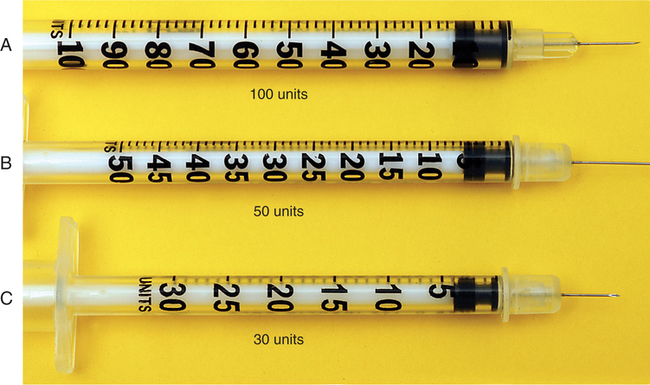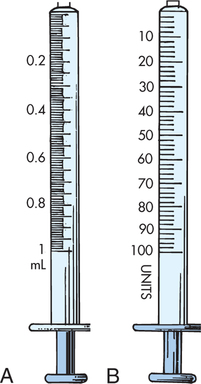• State the total volume capacity for various syringes. • Differentiate the calibrations (quantity values) for various syringe sizes per milliliter. • State the lowest and nearest measurable dose for syringes. • Select the appropriate syringe size for stated volumes. • Draw a vertical line through an accurate dose on a syringe. • Select the appropriate syringe for selected purposes. • Identify safety principles related to syringes and needles. • Define needle gauge and three criteria for needle selection. Liquid doses in mL for oral medications have been covered in Chapter 4 as well as an introduction to measuring syringe volumes with the 3-mL and the 5-mL syringe. Sufficient drawings and practice will be offered in this chapter so that syringe volume measurements for any syringes can be identified for providing the nearest measurable dose. The 3-mL and 5-mL syringes were introduced in Chapter 5 for oral liquid medications. Some intravenous medications may be given with large volume syringes (Figures 6-1 and 6-2). Intramuscular and intravenous injections may be given with a 5-mL syringe. It is used for doses of 5 mL or less (Figure 6-3) Many subcutaneous, intramuscular, and intravenous injections are given with a 3-mL syringe, used for doses of 3 mL or less (Figure 6-4). A 1-mL syringe is used for skin tests and some vaccines and may be used for infants’ injections and for very small doses. It is selected for doses of 1 mL or less (Figure 6-5). Be sure you can identify the lowest measurable dose on each of the following syringes. Insulin syringes are sized in 100 units, 50 units, and 30 units (Figure 6-6). A 100-unit insulin syringe is selected for insulin doses up to 100 units. Figure 6-8 shows the parts of a syringe. Syringes are supplied without needles or with attached needles. Supervised clinical practice is required in order to learn safe handling of syringes and needles. The 3-mL syringe is the most commonly used syringe for subcutaneous and intramuscular injections. The arrows illustrate the location of the 1- and 0.5-mL markings (Figure 6-9). The lowest measurable dose is 0.1 mL. Finding the total capacity and the lowest measurable dose involves the same process for all syringes. Syringe size selection is based on the medication dose ordered, the total volume of the syringe, and nearest: measurable dose on the syringe. Examine the empty 3-mL syringe shown in Figure 6-9 for a review: • The lowest measurable dose is 0.1 mL. • Medications for this syringe can be given to the nearest tenth of a milliliter (e.g., 2.2 mL, 2.3 mL, etc.) because that is the lowest measurable dose. • The calibrations are slightly more prominent for the whole-milliliter marks. • It is sometimes easier to count the lines to a whole number, if present, such as 0 to 1 mL, or between whole numbers, such as 1 and 2 mL. Keep in mind that smaller syringes may not have whole numbers. Examine the 1-mL syringe illustrated in Figure 6-5. It has 100 calibrations between 0 and 1 mL. In this case, the line count is more easily read between 0.1 and 0.2 mL. The dose in syringes is measured at the upper flat ring of the plunger, the ring closest to the needle end. For practice measurements, the plunger will not be shown (Figure 6-10). 1. How do the lowest measurable doses on the 10 and 20-mL syringe shown in the text differ from the lowest measurable doses on the 3- and 5-mL syringe? _________________________________________________________________________ 1. What are the two most commonly used sizes of syringes? _________________________________________________________________________
Syringe Measurements
Introduction
Syringe Sizes
20-mL, 10-mL, 5-mL, 3-mL, and 1-mL syringes




Insulin syringes
![]() Do not use insulin syringes for anything but insulin. Insulin doses are ordered in units. Avoid confusing insulin syringes with tuberculin syringes.
Do not use insulin syringes for anything but insulin. Insulin doses are ordered in units. Avoid confusing insulin syringes with tuberculin syringes.
![]() All used needles as well as their attached used syringes must be placed in hazardous waste sharps containers immediately after use. They may not be thrown in trash baskets.
All used needles as well as their attached used syringes must be placed in hazardous waste sharps containers immediately after use. They may not be thrown in trash baskets.
![]() Do not confuse 1-mL syringes or tuberculin syringes marked in milliliters (or cubic centimeters) with 1-mL insulin syringes, which are marked with the word insulin and calibrated in units (Figure 6-7).
Do not confuse 1-mL syringes or tuberculin syringes marked in milliliters (or cubic centimeters) with 1-mL insulin syringes, which are marked with the word insulin and calibrated in units (Figure 6-7).
Parts of the Syringe
Total Capacity and Lowest Measurable Dose
Where to Measure the Dose on Syringes
Syringe Measurements


















